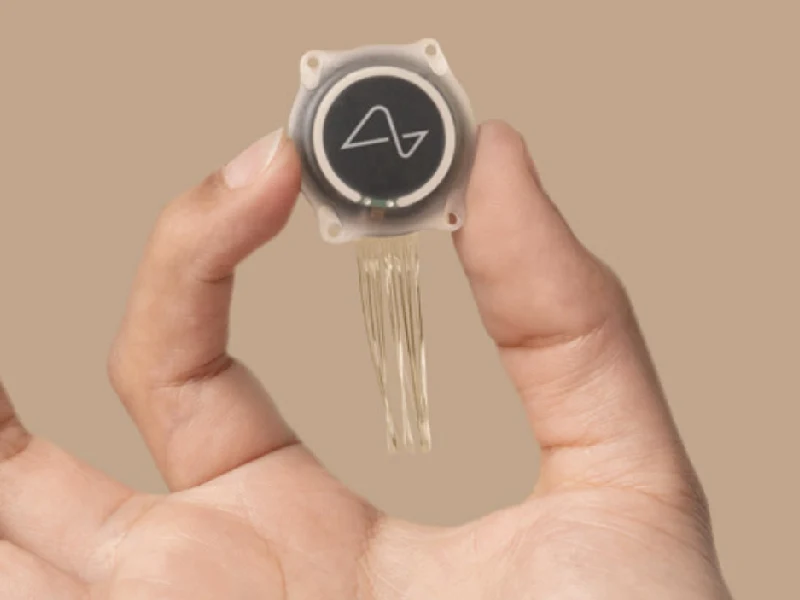எலோன் மஸ்கின் நியூராலிங்க் நரம்பியல் உலகில் பெரும் பரபரப்பை ஏற்படுத்தியுள்ளது. அதன் மூளை செயற்கை செருகி, "தி லிங்க்," என்பது கடுமையான உடலழிவைப் பெற்றவர்களுக்கு உதவ உருவாக்கப்பட்டுள்ளது. இந்த எதிர்கால தொழில்நுட்பம் மனித மூளையை கணினிகளுடன் இணைக்கும் திறன் கொண்டது, இதன் மூலம் பயனர்கள் தங்கள் எண்ணங்களை மட்டுமே பயன்படுத்தி டிஜிட்டல் சாதனங்களை கட்டுப்படுத்தலாம். அறிவியல் கற்பனை கதைகளைப் போல தோன்றும் இந்த தொழில்நுட்பம், நியூராலிங்கின் முதல் மனித பரிசோதனைகள் ஏற்கனவே தொடங்கியுள்ளன.
ஆனால், இது எப்படி வேலை செய்கிறது? அதன் நன்மைகள் என்ன? மேலும் எந்தவொரு ஆபத்துக்களும் உள்ளனவா? இங்கே நியூராலிங்கின் ஆழமான பார்வை:
நியூராலிங்கின் மூளை செயற்கை செருகி என்றால் என்ன?
நியூராலிங்கின் மூளை செயற்கை செருகியான தி லிங்க், நாணயத்தின் அளவுள்ள ஒரு சாதனமாகும், இது நேரடியாக மூளையில் பொருத்தப்படுகிறது. இந்த சிப் மிகவும் மெல்லிய மின் தொடர்புகள், அதாவது நரம்பு நூல்கள் மூலம் மூளை சிக்னல்களைப் பெறுகிறது மற்றும் அவற்றை புளூடூத் வழியாக வெளிப்புற சாதனங்களுக்கு அனுப்புகிறது. இதன் மூலம் பயனர்கள் கணினிகள், ஸ்மார்ட்போன்கள் மற்றும் செயற்கை கைகளை தங்கள் எண்ணங்களை மட்டுமே பயன்படுத்தி கட்டுப்படுத்த முடியும்.
இந்த தொழில்நுட்பத்தின் முக்கிய இலக்கு உடலழிவைப் பெற்றவர்களுக்கு இயக்கம் மற்றும் தொடர்பு திறன்களை மீட்டெடுக்க உதவுவதாகும். சேதமடைந்த நரம்பு பாதைகளை மீறி, நியூராலிங் இழந்த செயல்பாடுகளை மீட்டெடுக்கவும், உடலாழிவைப் பெற்றவர்களுக்கு உலகத்துடன் புதுமையான முறையில் தொடர்பு கொள்ள உதவவும் முனைவதாக உள்ளது.
நியூராலிங்க் எப்படி வேலை செய்கிறது?
தி லிங்க், மூளை செயல்பாடுகளை டிஜிட்டல் கட்டளைகளாக மாற்றுகிறது. இது, பயனர் ஒரு கர்சரை நகர்த்த நினைக்கும் போது, ஒரு பொத்தானை அழுத்த நினைக்கும் போது அல்லது ஒரு வார்த்தையை தட்டச்சு செய்ய நினைக்கும் போது, மூளை செயற்கை செருகி அவற்றைச் செருகி, இணைக்கப்பட்ட சாதனத்திற்குத் தகவலை அனுப்புகிறது.
உதாரணமாக, உடலழிவு பெற்ற ஒருவர் நியூராலிங்கைப் பயன்படுத்தி:
- ஒரு கணினி கர்சரை தொடாமல் இயக்கலாம்
- எழுத்துக்கள் தட்டச்சு செய்ய எண்ணினால் செய்திகளை அனுப்பலாம்
- செயற்கை கைகளை இயக்கலாம்.
நியூராலிங்கின் அமைப்பு செயற்கை நுண்ணறிவையும் (AI) இயந்திர கற்றலையும் (Machine Learning) பயன்படுத்துகிறது, இது நேரத்திற்கேற்ப அதன் செயல்திறனை மேம்படுத்துகிறது. இது பயனரின் எண்ணங்களை அதிக துல்லியமாக புரிந்துகொள்வதற்கும், சிக்கலான செயல்களை எளிதாக செய்ய உதவுகிறது.
நியூராலிங்கின் சாத்தியமான நன்மைகள்

இந்த தொழில்நுட்பம் பொதுவாக கிடைக்கக்கூடியதாக வந்தால், மருத்துவம் மற்றும் தொழில்நுட்ப உலகில் பெரும் புரட்சியைக் கொண்டு வரலாம். இதன் சில முக்கியமான நன்மைகள்:
1. இயக்க திறனை மீட்டெடுக்கும்:
முதுகுநாண் காயங்கள் அல்லது நரம்பியல் கோளாறுகளால் பாதிக்கபட்டவர்களுக்கு மீண்டும் இயக்கத்திறன் கிடைக்க உதவும். செயற்கை கை அல்லது பாதங்களை இயக்குவதற்கு உதவலாம்.
2. தொடர்பு திறனை மேம்படுத்தும்:
பேச்சு குறைபாடுள்ளவர்கள், உதாரணமாக, ALS அல்லது Locked-in Syndrome இருப்பவர்களுக்கு, டிஜிட்டல் உரை அல்லது குரல் உதவியாளர்களை இயக்க முடியும்.
3. மருத்துவ ஆராய்ச்சியில் முன்னேற்றம்:
மூளை செயல்பாட்டைப் பற்றிய ஆழமான புரிதல்களை அளிக்க முடியும். பார்கின்சன்ஸ் நோய், மிருகநடை நோய் மற்றும் மன அழுத்தம் போன்றவற்றிற்கான புதுமையான சிகிச்சைகளை உருவாக்க உதவலாம்.
4. AI மூலம் மூளை திறனை மேம்படுத்துதல்:
செயற்கை நுண்ணறிவு உடன் ஒருங்கிணைத்து நினைவாற்றலை அதிகரிக்க முடியும். நேரடியாக எண்ணங்களை எழுத்தாக்கும் திறன் கிடைக்கலாம்.
சிக்கல்கள் மற்றும் நெறிமுறைகள்
இந்த தொழில்நுட்பம் அதிக ஆச்சரியத்தைக் கொடுத்தாலும், அதற்கு எதிராக பல்வேறு சிக்கல்கள் மற்றும் நெறிமுறைகள் எழுந்துள்ளன:
1. நீண்ட கால உடல்நலப் பிரச்சினைகள்:
நீண்ட கால பயணத்தில் மூளையில் பாதிப்புகள் ஏற்படுமா? மூளை இந்த செயற்கை செருகியை நிராகரிக்குமா? இவை இன்னும் ஆய்வில் உள்ள கேள்விகள்.
2. அறுவை சிகிச்சை அபாயங்கள்:
இந்த சாதனத்தை பொருத்த, சிறிய அளவிலான மூளை அறுவை சிகிச்சை தேவைப்படும். அறுவை சிகிச்சையால் ஏற்படும் நோய்த்தொற்றுகள், இரத்தக்கசிவு போன்ற அபாயங்கள் இருக்கலாம்.
3. தகவல் பாதுகாப்பு சிக்கல்கள்:
மூளையிலிருந்து கணினிக்கு இடையிலான இடைமுகங்களுடன், ஹேக்கிங், கண்காணிப்பு மற்றும் மூளைத் தரவை அங்கீகரிக்கப்படாத அணுகல் பற்றிய கவலைகள் குறிப்பிடத்தக்கவை. ஹேக்கர்கள் நியூராலிங்க் சாதனங்களை அணுக முடிந்தால், அவர்கள் முக்கியமான நரம்பியல் தகவல்களை கையாளலாம் அல்லது திருடலாம்.
4. விலங்குகள் மீதான சோதனை தொடர்பான சர்ச்சைகள்:
நியூராலிங்க் அதன் விலங்கு சோதனை நடைமுறைகளுக்காக விமர்சனங்களை எதிர்கொண்டுள்ளது. குரங்குகள் மற்றும் பன்றிகள் உள்ளிட்ட சோதனைக்கு உட்படுத்தப்பட்டவர்கள் பாதகமான விளைவுகளை அனுபவித்ததாக அறிக்கைகள் தெரிவிக்கின்றன. இது தொழில்நுட்பம் பொறுப்புடன் உருவாக்கப்படுகிறதா என்பது குறித்த நெறிமுறை கவலைகளை எழுப்பியுள்ளது.
தற்போதைய முன்னேற்றங்கள் மற்றும் சவால்கள்
2024 ஆம் ஆண்டின் தொடக்கத்தில், நியூராலிங்க் தனது முதல் மனித மூளை செயற்கை செருகியை வெற்றிகரமாக பொருத்தியது. நோலன் ஆர்போ, உடலழிவு பெற்ற ஒரு நோயாளி, தன் எண்ணங்களை மட்டுமே பயன்படுத்தி கணினியை இயக்க முடிந்தார். ஆனால் சில வாரங்களுக்குப் பிறகு, மெல்லிய மின் தொடர்புகள் மூளையிலிருந்து பிரிந்து, சாதனத்தின் செயல்திறன் குறைந்தது.
நியூராலிங்க் பொறியாளர்கள் விரைவாக திருத்தங்களைச் செய்து, செயல்திறனை மீட்டெடுத்தனர். ஆனால் இந்த சம்பவம் மூளை செயற்கை செருகிகளை நீண்ட காலம் பயன்படுத்துவது தொடர்பான சவால்களை சுட்டிக்காட்டுகிறது.
நியூராலிங்கின் எதிர்காலம்
மஸ்க் ஒரு நாளில் நியூராலிங்க் சாதனங்கள் மனிதர்களின் அறிவுத்திறனை மேம்படுத்தவும், செயற்கை நுண்ணறிவுடன் ஒருங்கிணைக்கவும் பயன்படுத்தப்படும் எனக் கனவு காணுகிறார்.
இறுதி கருத்துகள்
நியூராலிங்கின் மூளை செயற்கை செருகி நவீன அறிவியல் உலகில் மிகப்பெரிய கண்டுபிடிப்பாக பார்க்கப்படுகிறது. இது வெற்றியடையும் பட்சத்தில், மருத்துவ உலகை மாற்றியமைக்கலாம், உடலழிவு பெற்றவர்களுக்கு உதவலாம், மேலும் மனிதர்கள் செயற்கை நுண்ணறிவுடன் இணைந்து முன்னேறவும் உதவலாம்.
ஆனால், இதற்கான தொழில்நுட்ப, நெறிமுறை மற்றும் பாதுகாப்பு சிக்கல்கள் முழுமையாக தீர்க்கப்படுவதற்கு இன்னும் நேரம் தேவை. இந்நுட்பத்தின் பயணம் தொடங்கியுள்ளதோன்றினும், அதன் தாக்கம் கோடிக்கணக்கான மக்களுக்குத் திசையாற்றக்கூடியதாக இருக்கும்.
நீங்கள் உங்கள் திறனை மேம்படுத்த மூளை செயற்கை செருகி பொருத்த விரும்புகிறீர்களா? உங்கள் எண்ணங்களை எங்களுடன் பகிருங்கள்!



